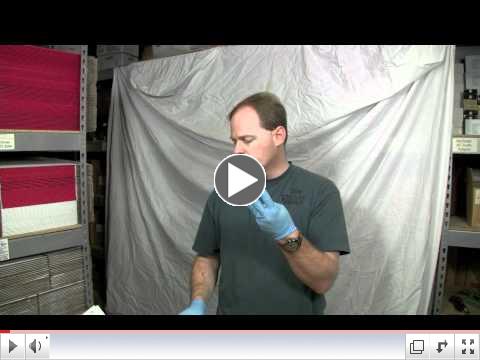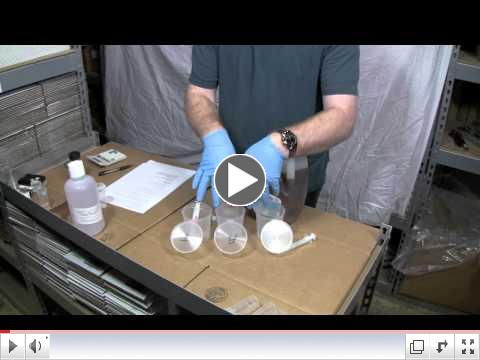|
-by Graydon Blair, Utah Biodiesel Supply
I have a really easy way to remember how Biodiesel is made simply by using your hands and a little imagination. With this lesson, I cover the basic transesterification reaction (base reaction), esterification (acid reaction), and deal with soap & glycerin production.
If you've ever called in and had a chemistry related question, you may have heard me use this analogy. I like it because it's simple, to the point, and is easy to remember. While it may not be 100% correct for the true chemists out there, it gets the point across well enough for understanding how Biodiesel is produced, what can hinder the reaction, and why we do crazy things like titrate and measure soap levels along the way. So, here we go!
Take your left hand and make the number 3 (3 fingers up, thumb & pinky down). In nature, organic oils at a molecular level look something like your hand. They each have three fatty acids (represented by your fingers sticking up) and a glycerin backbone (the palm of your hand). We call this molecule a Tri-glyceride (tri for 3 fatty acids; glyceride, being the combination of the glycerin/fatty acids together).
The Chemical Reaction
To make Biodiesel, we use a catalyst such as Sodium Hydroxide (NaOH, Lye), or Potassium Hydroxide (KOH, Caustic Potash). We also use Methanol as well. The combination of a single Fatty Acid Chain to a methanol molecule is what we call Biodiesel (or a fatty acid methyl/ethyl ester).
In relation to your hand, how the reaction works is that the catalyst (NaOH or KOH) acts as a cutting device between your palm and your fingers. It makes a nice, clean cut at the base of the finger and the methanol attaches to the finger where the cut was made creating a Biodiesel molecule. After all 3 fingers are detached from the hand, the hand becomes a single glycerin molecule.
So, one single tri-glyceride when fully reacted with the methanol & catalyst, creates 3 Biodiesel molecules and one glycerin molecule. The Biodiesel is lighter (less dense) than the glycerin so after the reaction has occured, the heavier glycerin molecules settle to the bottom.
In theory, when Biodiesel is made, each tri-glyceride (3 fingered hand) reacts with the catalyst to create Biodiesel and glycerin. Of course, that's in a perfect world.
The Free Fatty Acid Problem
As organic oils are used up in deep fryers and also as they age, the triglycerides tend to break down and the fatty acids break off and the oil breaks down.
A good way to think of this occurring with the hand example is by imagining that rust starts to occur where some of the fingers are attached to your palm. Eventually, the fingers "rust away" and detach from the palm completely creating what we call free fatty acids (acids that aren't bound to anything).
When the catalyst comes in to make a clean cut on the other fingers still attached, the fingers (free fatty acids) with the rust on the end attack the catalyst before it can even get to your hand. These rusted fingers begin bonding to the catalyst and create soap. The catalyst, being neutralized by the free fatty acids can't properly cut the still-attached fingers.
To ensure that we can still make Biodiesel from the fingers still attached to the palm, we add enough extra catalyst so that the there's still some left over after the free fatty acids have attacked and neutralized a portion of the catalyst.
Titrating Oil For Biodiesel
To find out how much extra catalyst is necessary to fully neutralize all the free fatty acids into soap and still have enough left over to make Biodiesel with, we perform a titration on the oil.
In reality, all we're doing oil is counting how many fingers are floating in the oil that aren't attached to hands. We then take that number and add it to how much catalyst is needed to cut the rest of the fingers still attached to hands. When the Biodiesel is made, the extra catalyst added reacts with the floating rusted fingers (free fatty acids) converting them into soap. Then, the left-over catalyst cuts the remaining fingers away from the hands and they are then free to bond to the methanol creating Biodiesel.
 | | Click the video above to see the hand example illustrated |
 | | Click the video above to see an actual titration performed |
How Sulfuric Acid Works On Waste Vegetable Oil
Sulfuric Acid can be used on oil that titrates really high to effectively lower it's titration. Here's how it works in relation to our hand example. Imagine that the Sulfuric Acid is sand paper. It attacks the rusty fingers that have broken away from the hand and begins to sand down the rusty ends.
In addition to having Sulfuric Acid, methanol is also added to the oil at the same time. As the acid is able to sand down the rust from each finger, methanol comes in and attaches to the fingers to create Biodiesel. Unfortunately, some of the fingers are rusted so badly that the acid sand paper isn't able to fully clean the rust off...those will still get reacted into soap. However, the acid is able to clean up a pretty large number of the rusted fingers thereby allowing them to react into Biodiesel.
So, as the number of fingers left floating in the oil is reduced, the titration level gets reduced. After the acid has done it's job, the oil is retitrated and the catalyst and more methanol get added to react the fingers still attached to the hands into Biodiesel.
Click here to learn the actual method for using Sulfuric Acid when making Biodiesel.
Click Here to learn the actual method for titrating
|